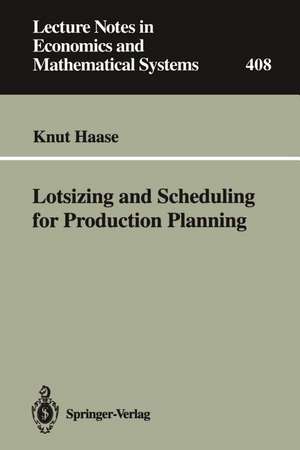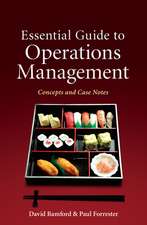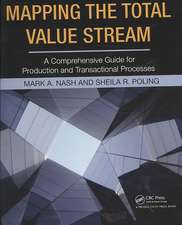Lotsizing and Scheduling for Production Planning: Lecture Notes in Economics and Mathematical Systems, cartea 408
Autor Knut Haaseen Limba Engleză Paperback – 27 mai 1994
Din seria Lecture Notes in Economics and Mathematical Systems
-
 Preț: 360.02 lei
Preț: 360.02 lei -
 Preț: 383.93 lei
Preț: 383.93 lei -
 Preț: 384.09 lei
Preț: 384.09 lei -
 Preț: 380.07 lei
Preț: 380.07 lei -
 Preț: 446.26 lei
Preț: 446.26 lei -
 Preț: 497.37 lei
Preț: 497.37 lei -
 Preț: 380.84 lei
Preț: 380.84 lei -
 Preț: 384.86 lei
Preț: 384.86 lei -
 Preț: 378.34 lei
Preț: 378.34 lei -
 Preț: 399.67 lei
Preț: 399.67 lei - 20%
 Preț: 360.93 lei
Preț: 360.93 lei - 15%
 Preț: 643.16 lei
Preț: 643.16 lei -
 Preț: 379.09 lei
Preț: 379.09 lei -
 Preț: 404.74 lei
Preț: 404.74 lei -
 Preț: 385.62 lei
Preț: 385.62 lei - 15%
 Preț: 644.49 lei
Preț: 644.49 lei -
 Preț: 379.09 lei
Preț: 379.09 lei -
 Preț: 345.50 lei
Preț: 345.50 lei -
 Preț: 425.80 lei
Preț: 425.80 lei -
 Preț: 378.34 lei
Preț: 378.34 lei - 18%
 Preț: 775.65 lei
Preț: 775.65 lei -
 Preț: 392.60 lei
Preț: 392.60 lei -
 Preț: 401.61 lei
Preț: 401.61 lei - 15%
 Preț: 646.43 lei
Preț: 646.43 lei -
 Preț: 382.18 lei
Preț: 382.18 lei -
 Preț: 378.34 lei
Preț: 378.34 lei - 15%
 Preț: 637.59 lei
Preț: 637.59 lei - 15%
 Preț: 647.27 lei
Preț: 647.27 lei -
 Preț: 377.73 lei
Preț: 377.73 lei -
 Preț: 447.84 lei
Preț: 447.84 lei - 15%
 Preț: 644.49 lei
Preț: 644.49 lei -
 Preț: 386.00 lei
Preț: 386.00 lei - 15%
 Preț: 654.43 lei
Preț: 654.43 lei -
 Preț: 415.02 lei
Preț: 415.02 lei -
 Preț: 411.54 lei
Preț: 411.54 lei -
 Preț: 398.92 lei
Preț: 398.92 lei -
 Preț: 398.92 lei
Preț: 398.92 lei -
 Preț: 392.75 lei
Preț: 392.75 lei - 15%
 Preț: 635.47 lei
Preț: 635.47 lei - 20%
 Preț: 653.56 lei
Preț: 653.56 lei -
 Preț: 379.86 lei
Preț: 379.86 lei -
 Preț: 495.46 lei
Preț: 495.46 lei -
 Preț: 447.99 lei
Preț: 447.99 lei -
 Preț: 378.71 lei
Preț: 378.71 lei - 15%
 Preț: 637.13 lei
Preț: 637.13 lei -
 Preț: 385.84 lei
Preț: 385.84 lei -
 Preț: 378.54 lei
Preț: 378.54 lei - 15%
 Preț: 666.55 lei
Preț: 666.55 lei -
 Preț: 380.07 lei
Preț: 380.07 lei
Preț: 632.37 lei
Preț vechi: 743.97 lei
-15% Nou
Puncte Express: 949
Preț estimativ în valută:
121.01€ • 126.60$ • 100.52£
121.01€ • 126.60$ • 100.52£
Carte tipărită la comandă
Livrare economică 03-17 aprilie
Preluare comenzi: 021 569.72.76
Specificații
ISBN-13: 9783540578338
ISBN-10: 3540578331
Pagini: 132
Ilustrații: VIII, 118 p.
Dimensiuni: 155 x 235 x 7 mm
Greutate: 0.2 kg
Ediția:Softcover reprint of the original 1st ed. 1994
Editura: Springer Berlin, Heidelberg
Colecția Springer
Seria Lecture Notes in Economics and Mathematical Systems
Locul publicării:Berlin, Heidelberg, Germany
ISBN-10: 3540578331
Pagini: 132
Ilustrații: VIII, 118 p.
Dimensiuni: 155 x 235 x 7 mm
Greutate: 0.2 kg
Ediția:Softcover reprint of the original 1st ed. 1994
Editura: Springer Berlin, Heidelberg
Colecția Springer
Seria Lecture Notes in Economics and Mathematical Systems
Locul publicării:Berlin, Heidelberg, Germany
Public țintă
ResearchCuprins
1. Introduction.- 1.1 Objectives of Lotsizing and Scheduling.- 1.2 Classification of Problems.- 1.3 Outline of the Following Chapters.- 2. Single-Level Capacitated Lotsizing Problems.- 2.1 The Capacitated Lotsizing Problem (CLSP).- 2.2 Critique on the CLSP.- 2.3 The CLSP with Linked Lotsizes (CLSPL).- 3. Single-Level Lotsizing and Scheduling Problems.- 3.1 The Discrete Lotsizing and Scheduling Problem (DLSP).- 3.2 The Continuous Setup Lotsizing Problem (CSLP).- 3.3 A New Model — The Proportional Lotsizing and Scheduling Problem (PLSP).- 3.4 Model Comparison.- 4. Extensions of the PLSP.- 4.1 The PLSP with Setup Times.- 4.2 The PLSP with Sequence Dependent Setup Costs.- 4.3 The Multi-Machine PLSP with Make-or-Buy Decisions.- 4.4 The PLSP with Backordering and Stockouts.- 4.5 The Multi-Level PLSP with One Bottleneck.- 4.6 Concluding Remarks.- 5. Control of Stochastic Algorithms via Sequential Analysis.- 5.1 Hypotheses Test Problem for Reducing the Parameter Space.- 5.2 Sequential Tests of Hypotheses Concerning Quantiles.- 5.3 Monte-Carlo Study for Sequential Tests.- 5.4 An Example.- 5.5 Concluding Remarks.- 6. A New Class of Stochastic Heuristics for the PLSP and the CLSPL.- 6.1 Biased Random Sampling via Randomized Regrets for the PLSP.- 6.2 Regrets for PLSP Extensions.- 6.3 Modifications for the CLSPL.- 6.4 Integration of Parameter Control via Sequential Analysis.- 6.5 Relations to Local Search Methods.- 7. Computational Results.- 7.1 An Instance Generator.- 7.2 Computational Results for the PLSP.- 7.3 Computational Results for the CLSPL.- 8. Summary and Future Work.- Appendix Monte-Carlo Study for Sequential Tests.












